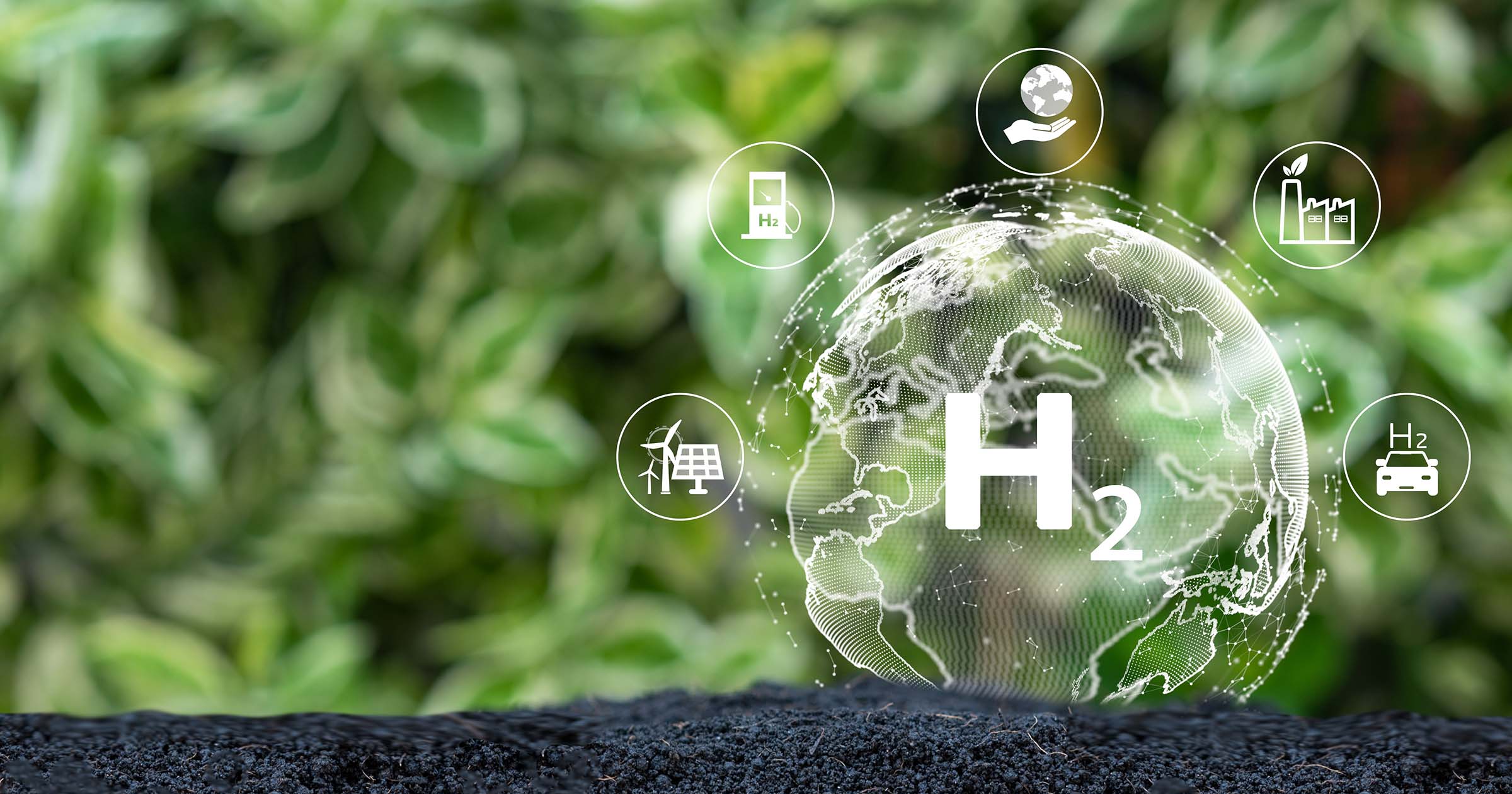As the world shifts towards greener energy solutions, the spotlight on hydrogen fuel cells grows brighter. Harnessing the power of hydrogen, these cells present a clean energy alternative capable of meeting the escalating global demand for power. But what are hydrogen fuel cells? In its most basic form, a hydrogen fuel cell is a device that converts the chemical energy stored in hydrogen into electrical power through an electrochemical process instead of combustion.
Hydrogen fuel cells offer an efficient, reliable alternative to traditional power sources. This simple concept has taken on a life of its own, with researchers and scientists developing various types of hydrogen fuel cells that are scalable and adaptable to multiple use cases such as transportation, manufacturing and space exploration to name a few.
Revolutionizing the way the world powers mission-critical environments, hydrogen fuel cells hold many advantages. Let’s explore the fundamental principles, the specialized roles of fuel cell variants, the benefits and what the future holds for fuel cells.
Unlocking Power: How Does A Hydrogen Fuel Cell Work?
A hydrogen fuel cell operates through an electrochemical process that transforms the energy stored in hydrogen gas (H2) and oxygen into electrical power without combustion. The magic happens in what is known as the fuel cell stack that is responsible for facilitating the electrochemical reactions, which are comprised of the anode, cathode and electrolyte. Here’s a closer look:
- Anode: An electrode at which the electrochemical oxidation of hydrogen takes place. It is typically carbon-based and coated with a catalyst such as platinum.
Function: When hydrogen gas is supplied to the anode, a catalyst facilitates the splitting of hydrogen molecules into protons and electrons. The electrolyte guides the protons to the cathode while the electrons are compelled to traverse an external circuit, generating an electrical current in the process.
- Cathode: An electrode at which the electrochemical reduction of oxygen takes place. Like the anode, it is also typically composed of a porous material coated with a catalyst, often platinum.
Function: At the cathode, protons from the anode, electrons from the external circuit, and oxygen combine to form water (H2O). This reaction completes the electrochemical process and represents the final step in the generation of electricity.
- Electrolyte: A substance that conducts ions between the anode and cathode. It is crucial for facilitating the movement of protons (H+ ions) from the anode to the cathode.
Function: Facilitates the movement of protons from the anode to the cathode, allowing electrochemical reactions while preventing the direct mixing of hydrogen and oxygen.
The electrochemical reaction begins when hydrogen gas is supplied to the anode and oxygen, usually sourced from the air, is introduced to the cathode. Hydrogen molecules undergo a transformative split into protons and electrons. While protons seamlessly navigate through the electrolyte to reach the cathode, electrons are compelled to embark on an external circuit. This electron flow along the circuit generates an electric current – a flow of electricity that can be harnessed for energy.
Electrons are reunited with protons at the cathode, where they are combined with oxygen. The result? Pure water (H2O) emerges as the sole emission, signaling a notable shift away from the carbon emissions typically linked with traditional power generation methods reliant on combustion. This elegant electrochemical dance between hydrogen and oxygen not only yields electrical power but does so with remarkable simplicity and environmental friendliness.
In essence, the fuel cell stack orchestrates this intricate process, serving as the powerhouse where hydrogen and oxygen engage in their electrochemical tango. Hydrogen gas is the cornerstone of this reaction – it serves as the fuel, offering a clean and abundant source of energy. Harnessing oxygen from the atmosphere adds to the environmental attractiveness of hydrogen fuel cells as it’s available in abundance.
The beauty of this electrochemical process lies not only in its efficiency but also in its environmental sustainability. As the world seeks cleaner energy alternatives, the hydrogen fuel cell emerges as a compelling solution, providing power without the detrimental environmental impacts associated with traditional combustion-based methods.
Advanced Perspectives: Understanding the Specialized Roles of Fuel Cell Variants
Fuel cells come in various types, primarily categorized based on the electrolyte they utilize. While the fundamental principle remains the same, various types of hydrogen fuel cells have been developed, each with unique characteristics and applications. These characteristics, in turn, dictate the applications for which each type of fuel cell is most apt. The landscape of fuel cell technology is diverse, with several types currently under development. Each type of fuel cell presents its unique advantages, challenges, and potential use cases.
The distinction in electrolyte choice plays a pivotal role in shaping the electrochemical reactions within the cell, specifying the catalysts needed, determining the operating temperature range, and influencing the choice of fuel. Proton Exchange Membrane Fuel Cells (PEMFC), for instance, are commonly used in transportation, while Alkaline Fuel Cells (AFC) find applications in space exploration. Solid Oxide Fuel Cells (SOFC), another notable variant, operate at higher temperatures and are suitable for both stationary power generation and certain vehicle applications. This diversity highlights the adaptability of hydrogen fuel cells to different scenarios, contributing to their growing popularity across various industries.
- Proton Exchange Membrane Fuel Cells – Also called proton exchange membrane fuel cells, operate at relatively low temperatures with a low weight and compact design. It employs a polymer electrolyte membrane, which selectively allows protons to pass through while blocking electrons. These key features set PEMFCs apart, making them an ideal solution for applications like electric vehicles due to their quick start-up times and high power density.
- Alkaline Fuel Cells – The main distinction lies in their electrolyte composition, typically potassium hydroxide. Unlike PEMFCs, AFCs operate at higher temperatures and require an alkaline environment, which makes them suitable for specific applications where elevated temperatures are acceptable. They are commonly used in space exploration.
- Solid Oxide Fuel Cells – This hydrogen fuel cell, unlike PEMFCs and AFCs, operates at temperatures above 800 degrees Celsius. SOFCs employ a solid ceramic electrolyte, typically made of materials like yttria-stabilized zirconia. With a high operating temperature and efficiency in converting fuel into electric power, they are typically used for stationary power generation in large-scale industrial settings.
As one of the most promising sources of sustainable energy, hydrogen fuel cells offer a wide range of advantages that make them an appealing choice for a variety of applications.
Advantages of Hydrogen Fuel Cells
In the realm of clean energy, hydrogen fuel cells emerge as a promising alternative, providing a wide variety of environmental advantages that set them apart from traditional power sources. At the forefront is their capacity for zero-emission energy production. The only byproduct of the electrochemical reaction is water vapor, contributing to a significant reduction in greenhouse gas emissions. This marks a significant departure from the carbon emissions associated with burning fossil fuels, making hydrogen fuel cells a crucial player in mitigating climate change and reducing air pollution.
Beyond their environmental friendliness, hydrogen fuel cells boast higher efficiency than traditional combustion technologies. In a fuel cell, the conversion of hydrogen into electricity is a more direct and efficient process than the combustion of fossil fuels, yielding higher energy conversion rates. Their versatility and scalability make them suitable for a range of uses, including transportation, residential power, and portable electronic devices.
Hydrogen fuel cells are versatile and can be applied across a spectrum of power generation scenarios, showcasing their adaptability and reliability. They can operate continuously, providing a reliable source of power with minimal environmental impact. Additionally, the scalability of fuel cell technology allows for seamless integration into diverse power generation infrastructures, from small-scale residential units to large industrial facilities.
The advantages extend beyond environmental considerations to encompass reliability, as hydrogen fuel cells can deliver consistent power for longer durations, acting as backup power sources during grid outages or as primary power systems in remote areas. This reliability is particularly valuable in situations where continuous power availability is critical.
The automotive industry has embraced hydrogen fuel cells as a clean alternative to traditional internal combustion engines. Hydrogen fuel cell vehicles (FCVs) offer longer ranges and shorter refueling times compared to battery electric vehicles, addressing some of the challenges associated with electric transportation.
The versatility of hydrogen fuel cells is a defining feature, making them suitable for an array of applications. Whether it’s powering a residence, an industrial facility, or a transportation, hydrogen fuel cells exemplify a transformative force in the landscape of clean and efficient energy solutions.
Driving Change: The Evolving Landscape of Fuel Cell Innovations
Fuel cell research is a dynamic field, with scientists exploring novel materials and designs to enhance the performance of hydrogen fuel cells. One notable advancement is the focus on improving the durability and performance of fuel cell components, ensuring prolonged and efficient operation by generating a higher voltage.
In terms of efficiency, ongoing research is exploring methods to increase the energy conversion rates within fuel cells. This involves optimizing catalysts and electrode materials to enhance the electrochemical reactions, thereby maximizing the yield of electrical power. These innovations aim to increase power output, extend the lifespan of fuel cells, and reduce manufacturing costs, ultimately making hydrogen fuel cells more accessible and economically viable.
The advancement of control technology and system integration also contribute to the overall efficiency of hydrogen fuel cell systems. Smart control systems enable better management of power output, ensuring that energy is harnessed and distributed optimally.
While hydrogen is a clean and abundant fuel, it is traditionally sourced from natural gas. The production methods of hydrogen play a crucial role in determining the overall environmental impact of fuel cell technology. Green hydrogen, produced using renewable energy sources, is gaining traction as a sustainable alternative to conventional methods that rely on natural gas. Innovations in the production and storage of hydrogen, a critical aspect of the technology, also contribute to the overall cost-effectiveness of hydrogen fuel cell systems. By utilizing renewable energy sources such as solar or wind power, this approach aims to create a closed-loop system with a minimal carbon footprint.
Navigating the Future with Hydrogen Fuel Cells
Hydrogen fuel cells are addressing the urgent global call for cleaner, more reliable energy alternatives. The simple elegance of these cells and their eco-friendly electrochemical process provide a sustainable alternative to traditional power. Crucially, the move towards green hydrogen production, utilizing renewable sources like solar and wind power, underscores a commitment to creating closed-loop systems with minimal environmental impact.
Hydrogen fuel cells not only champion environmental friendliness but also boast remarkable efficiency compared to traditional combustion methods. Their scalability and adaptability position them as a viable solution for various needs. The versatility of fuel cell variants demonstrates their adaptability across a spectrum of industries, from residential, commercial, transportation, and even space exploration.
As research propels fuel cell technology forward, the focus on durability, performance, and enhanced energy conversion rates aims to make hydrogen fuel cells more affordable and accessible.
Dive into how Bloom Energy’s fuel cell solutions can address your immediate energy needs. Our team of experts is ready to create a tailored solution built to fit your energy requirements. Together, let’s power a more sustainable and resilient future. Contact Us to start your journey towards efficient and reliable energy management with Bloom Energy.
FAQ
Q1. What Is a Hydrogen Fuel Cell?
A hydrogen fuel cell is a device that converts the stored energy in hydrogen into electrical power through an electrochemical process. It offers a clean and efficient alternative to conventional power sources.
Q2. How Does a Hydrogen Fuel Cell Work?
Hydrogen fuel cells operate through an electrochemical process, where hydrogen gas and oxygen combine to generate electrical power without combustion. The fuel cell stack, comprising an anode, cathode, and electrolyte, facilitates this process, leading to the production of electricity and water as the only byproduct.
Q3. How scalable are hydrogen fuel cells, and in what industries can they have the most significant impact?
Hydrogen fuel cells exhibit scalability ranging from small-scale applications in transportation, including electric vehicles, to large industrial systems powering manufacturing processes. In the transportation sector, Proton Exchange Membrane Fuel Cells (PEMFCs) stand out for their compact design, enabling quick start-up times in various vehicles. Their versatility extends to commercial power generation, offering a clean and efficient alternative for retail businesses, industrial plants and data centers.



